
|   |

|   |
 e-mail: janakipatrik@gmail.com MANDALA X / CREATION: A DANCE ORATORIO April 11, 2021 INSPIRATION MANDALA X / CREATION: A DANCE ORATORIO was inspired by "The Hymn of Creation", a 3,000-year-old Sanskrit hymn from the Rig Veda. One of the first known speculations on the origins of the universe - considered the oldest statement of philosophic doubt in world literature - "The Hymn of Creation" reverberates with eternal questions which have intrigued humankind. In 1976, my father's friend Dr. Mary Blade gave me the book Hymns from the Rig-Veda, translated by Jean Le Mee, published by A.Knopf in 1975, with photographs by Ingbert Gruttner. This gift started me on a choreographic journey, culminating twenty years later in the production MANDALA X - CREATION - A Dance Oratorio, which premiered on the Vernal Equinox, 20 March 1997. Professor Blade taught engineering at The Cooper Union for the Advancement of Science and Art in New York. Her colleague Dr. Jean LeMee exemplified the rare union of scientific rigor and wide-ranging interests in literature and cultures of the world. Chair of the Department of Mechanical Engineering at The Cooper Union, Dr. LeMee first studied Sanskrit at Columbia University. Subsequently he was a Visiting Senior Fellow at the South-East Asia Regional Studies Center of the University of Pennsylvania (1978-79) and a Fellow of the American Institute of Indian Studies in the Sanskrit Department of the University of Delhi (1983-84). It is clear that his was not a trendy brush with Indian language and culture, but rather a deeply felt and carefully researched knowledge of Sanskrit and the cultural context of the Rig Veda. In his book "Hymns from the Rig Veda" Professor Le Mee translated twelve Vedic hymns and wrote an illuminating introduction. The photographs by Ingbert Gruttner, which punctuate the text, proclaim the beauty of the earth on whose creation the ancient seers meditated. 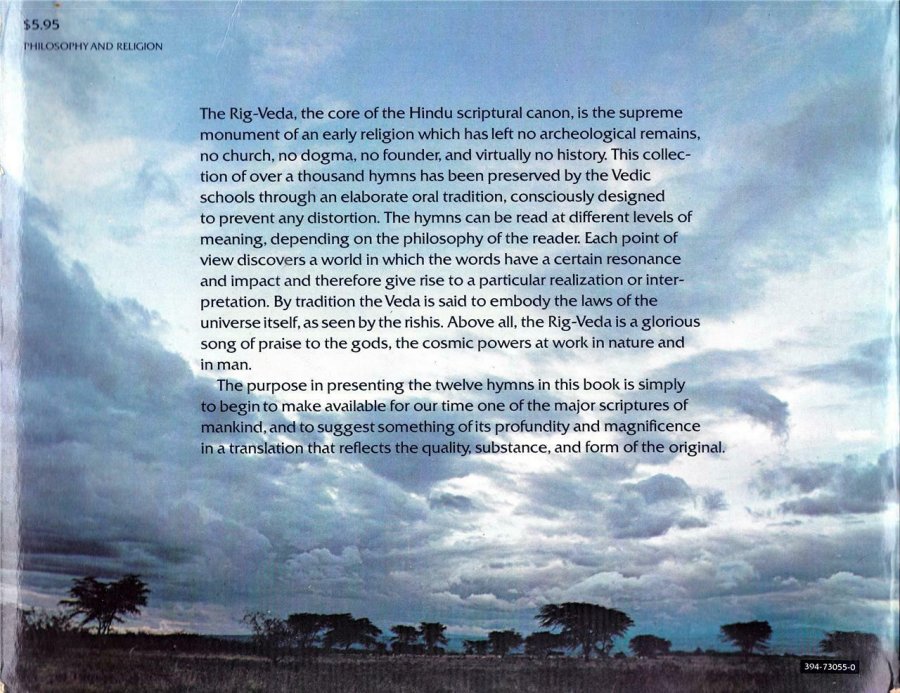 Photographer Ingebert Gruttner Every hymn was translated with simplicity and clarity of language. One hymn - Rig Veda X.129 - struck me with explosive power. Dr. Le Mee's introduction to this hymn reveals its underlying logic, poetry and mathematical precision.
Dr. Le Mee's translation of the Nasadiya Sukta inspired in me a burning desire to manifest the majesty of its vision in movement. Perhaps I recognized in this hymn the quest for answers about origins of the universe, which drove my father's life-long search for a union of science and spiritual inspiration. From age six until his voice changed from soprano to tenor at age twelve, my father was a boy soprano at Grace Church, an Anglican Episcopal church in New York City. My father sang daily in the boys' choir - for Morning Prayers and Evensong, plus additional Sunday and special celebratory services. He was confirmed as a member of the Church and heard daily explications of its belief system in the services for which he and the other choirboys sang, devoting their voices to glorify god. 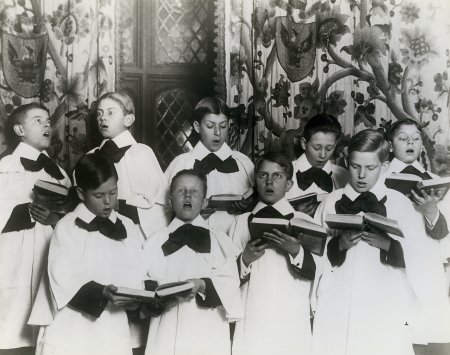 Grace Church Choir, April 1922: members of the Grace Church Boy Choir; Harold Hughes front row, 2nd from L 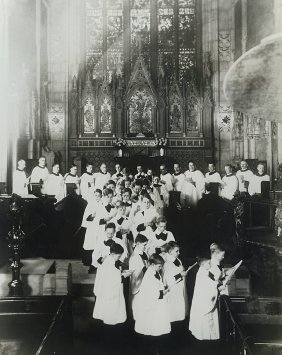 Grace Church Choir, April 1922: full choir leaving the Sanctuary Concurrent with his daily immersion in Christian hymns and sermons, my father's curiosity about how the world works raged on. Choirboys lived in a special hostel inside the church grounds. My father conducted his experiments in electricity and chemistry inside that hostel, to the harried exasperation of the hostel's matron. When the lights suddenly flickered and went out, or a smell of sizzling wires and acrid chemicals pervaded the air, she would go on a search for my father, shouting, "Where are you, Harold Hughes, you damned singing angel?" My father enrolled in Columbia University, searching for answers to some of his questions and eventually earning a PhD in physics. He also began to question his Christian faith and found a gaping disjuncture between its dogma and the laws of the natural world which he studied in physics. He eventually left the Anglican Church and joined the Unitarian-Universalist Church, which respects the beliefs of all religions. 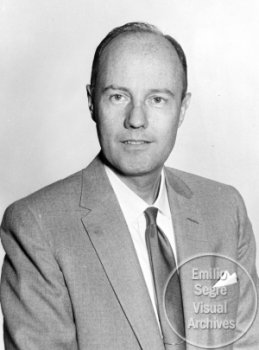 Dr. Harold Kenneth Hughes Until the end of his life my father searched for answers to the questions he had asked in early childhood, like the ancient seers in the Nasadiya Sukta. CONCEPT Dance writer Nala Najan asked me, "What inspired you as a choreographer and performer to create MANDALA X - to visualize the Hymn of Creation in contemporary terms, not as an exposition of Indian dance with a contemporary gloss?" 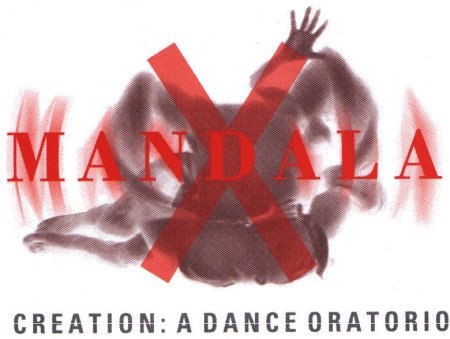 Design by Ram Rahman I answered, "In the 1970's when I first read the Nasadiya Sukta, I felt as if I had been hit by a bolt of lightning. All the certainty about the nature of the divine creative 'being'- which I had expected to find in India's most ancient sacred hymns - was shattered by the final verse of The Hymn of Creation, Rig Veda X.129: From where this creation arose - Whether it is upheld and sustained or not - Whoever looks down upon it from the highest heaven - Indeed he knows, .... or perhaps he does not know. Rig Veda X.129.7 - Translated by Janaki Patrik & Michael Ward in consultation with Dr. P. Jayaraman Since reading the final lines of this hymn, ideas about how to visualize its brooding doubt - musically and choreographically - had been simmering in my mind. I never conceived of the appropriate medium for this project in a classical dance or music format. I understand the nature of classicism to involve building expectations and structures, from which final resolution and fulfillment can be created. Whether it is a tihai (a thrice-repeated rhythmic pattern), which ends on the sam (the first beat of a time cycle), or the elegant structure of a Mozart symphony, classical arts play by the "rules of the game". No matter how much the players push against the boundaries of style and technique - no matter how much they flirt with the dangerous world "outside" - classical artists nevertheless tend to create a jewel-like and self-contained perfection. No loose ends. No unanswered questions. Wild animal energy, explosive and uneasy messiness, oozing outside boundaries of recognizable style - a constant, off-balance sense of "work-in-progress" - a sense of art out of control and just about to break out of the boundaries of performance space and into the "real" world ... these are some of the images and ideas which motivated MANDALA X's creation. 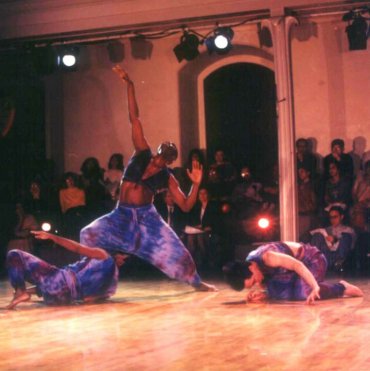  Photos (c) Richard Shpuntoff "Kathak, Bharata Natyam, Manipuri, Hindustani, Carnatic music.... all the classical music and dance styles of India - none by itself could express fully what I visualized. I did not want any homogeneity which classicism often implies. I saw the dancers as a very mixed group of people, physically and stylistically. I wanted the beauty of creation's diversity to be evident in the very bodies on which the choreography would manifest." Janaki Patrik, March 1997. 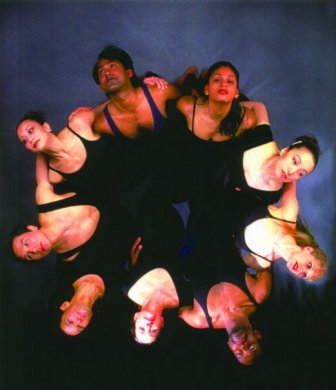 Dancers - Clockwise from top: Masud-ur-Rahman, Aparna Reddy, Masayo Tomita, Aimee Phelan, David Browne, Janaki Patrik, Ramli Ibrahim, Richard Chang, Benedetta Capanna Photo (c) Michael Lawrence MANIFESTING THE WORD The period between inspiration and realization of my productions can be short -- or very long. Something has to trigger a switch in my mind, propelling me from being satisfied with hearing whispers of melodies and glimpsing inchoate choreographic shadows in my mind. At least one of the critical components of a production has to materialize before I start to move purposefully and inexorably toward the finish line. In the case of MANDALA X, I knew that finding a composer was critical. Vedic hymns were preserved for millennia by an exacting system of four-tone Vedic chant, which is often considered the oldest unbroken oral tradition in existence. The composer would need to be sensitive to the rhythms of poetic speech, and would also need to be skilled in using melody to illuminate the meaning of words and their underlying emotional suggestions. Twenty years passed between my first reading the Nasadiya Sukta and that moment when I heard music which sparked my imagination. In 1996 I attended a performance of Shakespeare's play "Measure for Measure", produced by the New York City group Theatre for a New Audience. When I heard the music played in that production, I thought to myself, "That composer can create the sound palette necessary to illuminate the Nasadiya Sukta." That composer was - is - Michael Philip Ward, who considers that music is "the common language that unites humanity, and connects humanity with the divine." Sitting in the theater, watching a Shakespeare play, I knew nothing about Michael Philip Ward - that his mother was a concert pianist and father was a lover of American Dixieland jazz and early swing music; that he started to play the organ in his church at age 10 and became the church organist at age 14, playing three early morning masses every day before school. All I heard was a depth of emotion that went far beyond pretty melodies. His 2018 composition, "The Innkeeper's Song" exemplifies Michael's combination of words, melody and images to convey a profoundly spiritual message. Having engaged Michael in April 1996 to compose the music, my next step was for both of us to study the Sanskrit and understand the meanings of each word. The sarangi player Pandit Ramesh Misra lived with our family for three years, as he gradually shifted his home base from Kolkata to New York City. I asked Ramesh-ji whether he knew anyone in the New York Indian community who could translate Vedic Sanskrit. He immediately said, "Dr. Jayaraman at the Bharatiya Vidya Bhavan", and he took me to the Bhavan to meet him. I explained to Dr. Jayaraman, that I wanted to manifest the Nasadiya Sukta in melody and movement, and that the composer and I needed to understand each word, as well as the mnemonic devices, which had preserved the words of the Rig Veda for millennia. 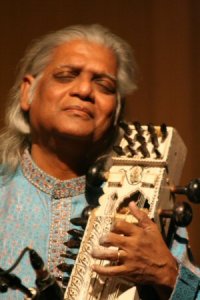 Pandit Ramesh Mishra 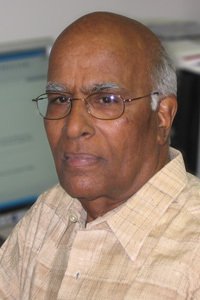 Dr.Jayaraman Dr. Jayaraman is steeped in the Vedic tradition, its texts and chanting. He might have been a conservative, an unbending traditionalist .... but he is not. I explained that I wanted the words of this glorious hymn to resound in music and movement, to be shared in time and space, rather than remain the preserve of just a few initiates. Though he had no clear idea of what I intended to create, Dr. Jayaraman's enthusiasm for the project reflected his adventurous and generous spirit. He graciously agreed to read through the Nasadiya Sukta with Michael and me. For several months thereafter Michael and I spent an afternoon every week with Dr. Jayaraman, hearing him chant the verses and listening to his explanations of the significance of each word - for example the multiple words for WATER and their nuances of meaning. After each session I would go home and try to use simple English words and syntax to convey the ecstatic wonder which the hymn conveys, and which Dr. Jayaraman was explicating to us. I did not try to match Dr. Le Mee's inspired poetic translation, which echoes the hymn's original Sanskrit meter. I had a simple goal - to help American audiences understand the meaning of the hymn. 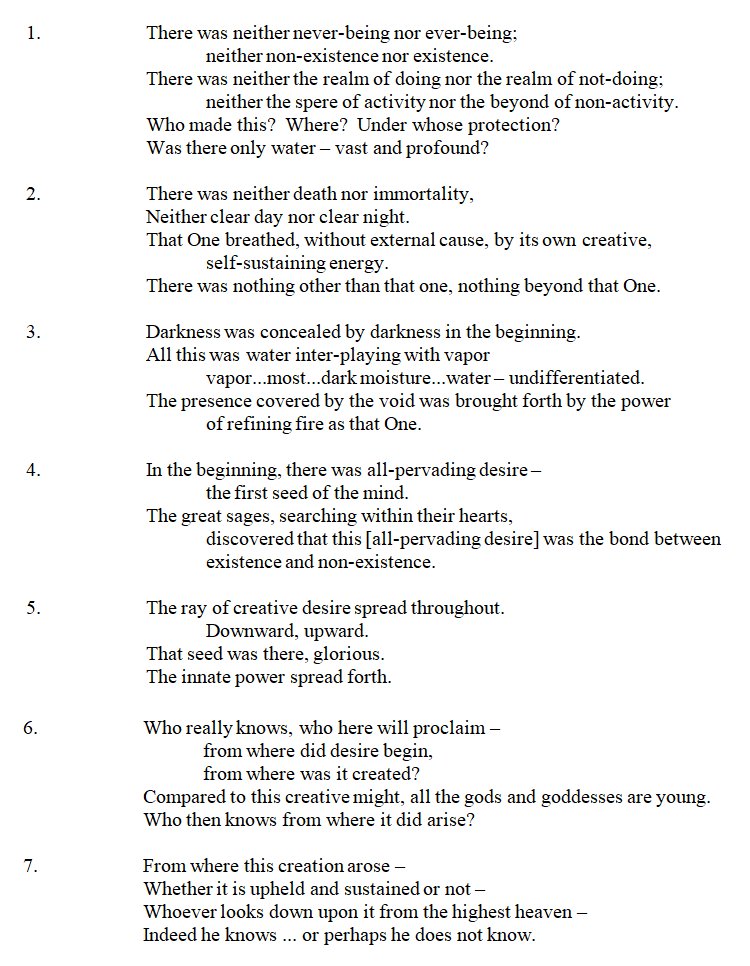
CONVEYING THE MEANING OF VEDIC SANSKRIT In my lifetime I have studied several foreign languages - Russian, Sanskrit, Braj, Hindi and Urdu. In each case I have put in the time and effort to study their vocabularies and grammars for one purpose only - to have access to the poetic repertoires of those languages. Because I listen to each new language with ears trained to hear musical detail, I am hyper-aware of the differing rhythmic and melodic cadences encapsulated in each language. As a result, I want the audience to hear the beauty of the original languages, but also understand the meanings of words in their mother tongue - English. At the same time I do not depend on English translations written in program notes or recited in a lecture-demonstration presented prior to a performance. I believe that these methods tend to separate the meaning from the beauty of its original verbal expression, and the audience is distracted from using its eyes to see the choreographic illumination of poetic words. Therefore, my productions are designed so that the audience hears the sounds of the original poetry, and also hears the English translation -interwoven into the performance itself. This goal informed my collaboration with Michael. Having jointly studied the Sanskrit words of the Nasadiya Sukta with Dr. Jayaraman, Michael and I discussed the predominant emotion - the rasa - which we wanted to convey in each stanza. We labored over the ways in which the English and Sanskrit could be interwoven in the music, and whether the vocabulary and syntax of our translation were simple enough. As he finished composing each part, Michael shared a computer simulation of his music. The simulation included the Sanskrit and English words exactly as they would be interwoven with the melody. FORMING A DANCE ENSEMBLE & Finding a Co-Choreographer As soon as Michael and I had worked through the first of the seven stanzas of the Nasadiya Sukta with Dr. Jayaraman, Michael started composing the music. Since Michael’s music score called for a choir, vocal and instrumental soloists and an orchestra, I used computer simulation when I choreographed. But even using electronically simulated music, it was thrilling to hear the text and melody played together. The opening music so clearly expressed the searching wonder of the chant, that I used it to audition dancers on 25 November 1996. I asked them to respond to the opening words and music of the first stanza, "There was neither never-being nor ever-being; neither non-existence nor existence..." I chose dancers who could move without the intent of being "pretty" - who didn't just string together classroom "dancey-dance" steps. I chose dancers who could express a raw, driven energy, like an animal caught in a car's headlamp -- David Browne, Benedetta Capanno, Richard Chang, Aimee Phelan, Masud-ur-Rahman, Aparna Reddy, Masayo Tomita. 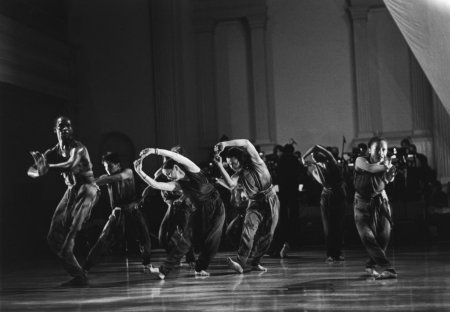 forefront-David Browne, Janaki, Ramli Photo (c) Tom Brazil 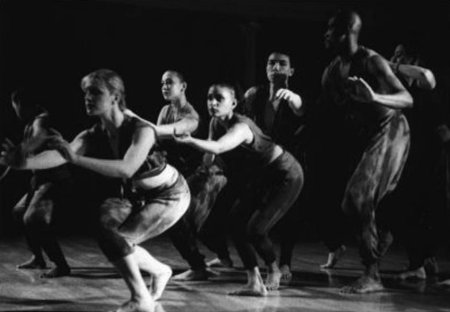 Photo (c) Tom Brazil MANDALA X's choreographic structure evolved from the concepts embedded in the Sanskrit word mandala - literally "a circle". The circular design of a mandala is meant to focus concentration, and to encourage introspection and awareness of an individual's place and purpose in the world. A mandala is also any of the ten books of hymns that comprise the Rig Veda. 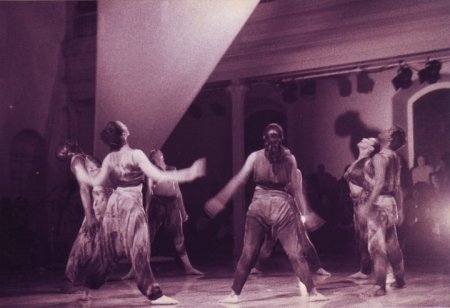 Photo (c) Tom Brazil The Hymn of Creation is included in the tenth and last book of the Rig Veda -- Mandala X. The title of this work, therefore, refers both to a specific text and to geometric form. The choreography draws freely from modern dance and theater techniques, as well as from Eastern dance idioms, and it suggests the powerful forces out of which the universe is imagined to have emerged: purush - male, pure consciousness; prakriti - female, procreative energy; retamsi - seeds; salila - water; tamas - darkness; tapas - inner, refining fire; kamas - desire; manas - thought. Because creation in the Hindu cosmogony is conceived as the union of male and female forces, finding a powerful male lead was critical. I asked my mentor and friend Indrani Rahman for her advice. She immediately suggested the Bharata Natyam, Odissi and modern ballet dancer-choreographer Ramli Ibrahim, whose dance company and school - Sutra Foundation - are located in Kuala Lumpur, Malaysia. Fortuitously, Ramli had been awarded an Asian Cultural Council grant and was spending time in New York City for his research. Indrani's timely suggestion gave MANDALA X not only its charismatic male lead, but also an inspired choreographer and gracious collaborator. 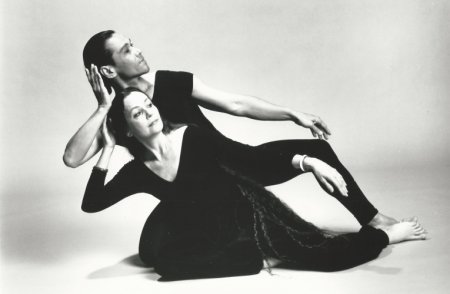 Photo (c) Herbert Migdoll Ramli, Michael and I met often in September, October and November 1996, before Ramli returned to Kuala Lumpur on November 12th. He would be returning to complete the second half of his grant only four weeks before the premier of MANDALA X. REHEARSAL SPACE Rental rates for rehearsal space in New York City are exorbitantly high. Moreover, finding a rehearsal space with as much availability as I needed for this large a production was challenging. My choreographic process is time-consuming. I don't go into the studio with preexisting, ready-made steps. The dancers and I work together. I give them images to evoke movement, coaching them to go even further when I see that they are "on the right track". Coaxing, selecting, arranging, I lead the dancers in the cooperative and mutual creation of choreography. Looking in my 1996 and 1997 diaries, I see almost every day filled with the names of rehearsal spaces and schedules. From 15th November 1996 through 18th March 1997, when we moved into DANSPACE for the tech and dress rehearsals, the dancers and I - and later, Ramli – rehearsed at least three days a week. Segue, Joyce SoHo, but mainly CHARAS / El Bohio – those were the names of the rehearsal spaces. We had many rehearsals in El Bohio, where I was able to book four-hour rehearsal slots. The word bohio is used for a West Indian thatched hut, and it's evident why the space was named that. Located in a de-commissioned, mostly empty school building a few blocks from my apartment on Manhattan's Lower East Side, the school had been seized at the height of New York City's fiscal crisis in 1977 by a group of predominantly Puerto Rican agitators. They created a community center, organized protests and provided the basic services which New York City was no longer providing in lower-income neighborhoods, including garbage pick-up, access to health care and jobs, and housing maintenance. El Bohio's brick exterior - its classic public school architecture - was structurally sound, but the inside was a wreck after years without the maintenance and repair of water leaks, peeling plaster and grimy floors. 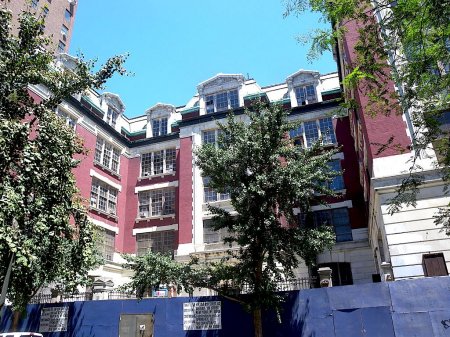 By late November 1996, when we started rehearsing in one of the few useable classrooms, the community center was desperately trying to hold out against NYC’s Mayor Giuliani’s efforts to sell the building to real estate developers. The only heat source was the sun streaming into the windows and a single air conditioner-heat pump. We had to wear socks, wool leg-warmers and layers of sweatshirts, sweaters and even gloves during the coldest mid-winter days. A SACRED SPACE According to the concept Naad Brahma, the universe is created from the primal sound OM. Sound - vibration - is thus conceived as the progenitor of creation. This concept was central to my vision for performing the Nasadiya Sukta. I wanted the audience to feel the vibrations of the air as the dancers moved through space, embodying the words of this ancient meditation on creation. I envisioned the embodied words - the dancers - and the melodies and chanting which propelled them into space - to be felt by the audience. In New York City one of the most coveted venues for presenting dance - DANSPACE Project - is located in a sacred space - the historic St. Mark's Church-in-the-Bowery. Its construction was completed in 1799, and it has a long history of commitment to the arts as an integral part of worship. To accommodate the Poetry Project (founded in 1966) and Danspace Project (founded in 1974) the traditional church seating - long benches called "pews" - was gradually removed. This process was completed during the rebuilding of the church following a devastating fire in 1978. The floor of the entire sanctuary is now covered with hardwood flooring, creating an open space for worship, dance, poetry readings and community activities. 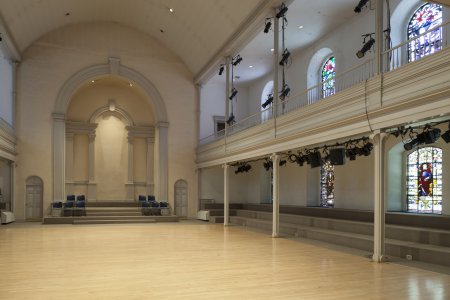 Danspace Project at St. Mark’s Church Photo by Anya Hitzenberger Though priority has traditionally been given to modern and post-modern dance productions, my application was accepted. I chose to premier MANDALA X during a 4-day performance run, which included a premier on the Vernal Equinox, Thursday, 20 March 1997. The orchestra was seated on the steps at the front of the sanctuary, leading to what had been the altar, and the choir stood above the main floor, on both sides of the overhanging balconies. To symbolize the emanation of creation from The Word, Dr. Jayaraman sat in padmasana on the floor at the focal point of a very large piece of fabric (a "sharktooth scrim") suspended from the three-story vaulted ceiling. This special theatrical fabric created a stream of light, which spread upward into the Sanctuary's soaring darkness. Dr. Jayaraman began the chant, and the dancers emerged from the light 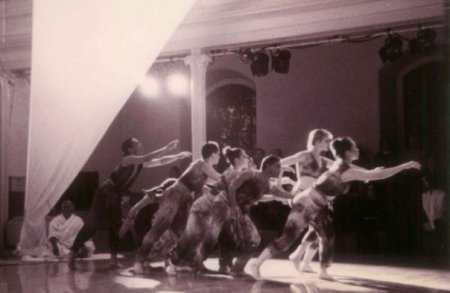 Photo (c) Tom Brazil 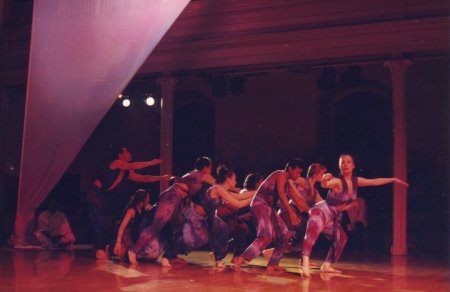 Photo (c) Richard Shpuntoff The chant initiated their movements : Who made this? Where? Under whose protection? Rig Veda X.129.1 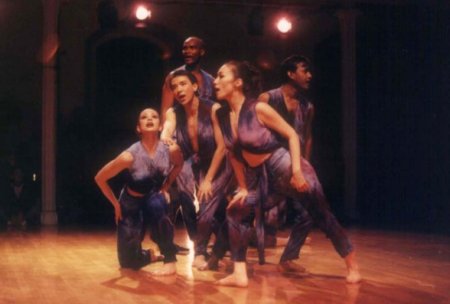 "Who made this?" Photo (c) Richard Shpuntoff "In the beginning, there was all-pervading desire..." Rig Veda X.129.4 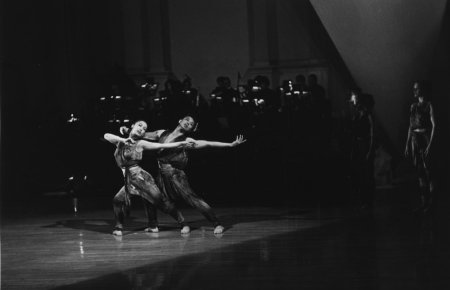 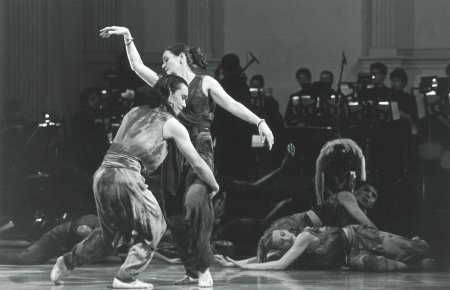 "The ray of creative desire spread throughout. Downward, upward. That seed was there, glorious. The innate power spread forth." Rig Veda X.129.5 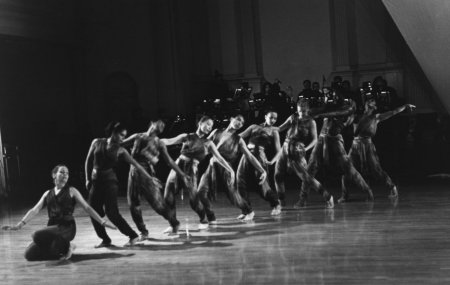 Photo (c) Tom Brazil Co-CHOREOGRAPHERS SPRINTING FOR THE FINISH LINE Ramli returned from Malaysia on 15 February 1997 and joined the production when it was poised to move to completion. His confident directions and dynamic choreography for the middle stanzas matched Michael's propulsive music for those sections. I had not envisioned myself dancing in the production. But Ramli has often appeared as the central dancer in his Sutra Foundation's productions, and so he choreographed me as his partner in MANDALA X - Prakriti and Purush, procreative energy and pure consciousness. 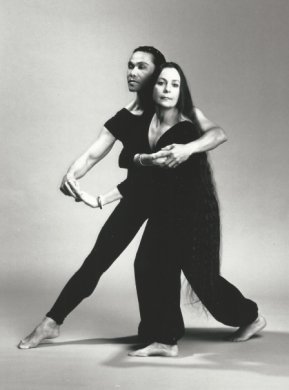 Photo (c) Herbert Migdoll RETURN TO THE SOURCE I had known from my first reading of the Nasadiya Sukta, that the last words of the hymn should be sung by a boy soprano. His pure high voice would ask the questions which the ancient seers and modern astrophysicists asked - and my father had asked when he was a young boy soprano and an old man. For many weeks Michael searched children's choirs throughout New York City to find a boy soprano who could sing in the performances of MANDALA X. Finally he found Willie Moller, boy soprano in the Grace Church Boy Choir. It still pierces my heart when I think how my father returned to ask his life-long questions - this time in the voice of another young boy from the same choir where he had sung eighty years before - this time in the words of the Nasadiya Sukta.
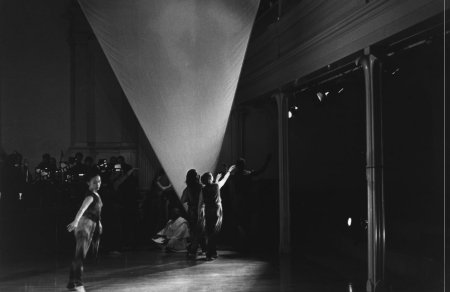 Photo (c) Tom Brazil As the light faded and this meditation on creation concluded, Purush and Prakriti walked out of the chant. Dr. Jayaraman sang the final blessing -- OM SHANTI - SHANTI - SHANTIHI - and the chant disappeared into the dark silence.
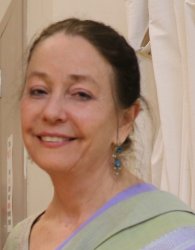 Trained in both classical Kathak dance (Pt. Birju Maharaj, beginning 1967) and Merce Cunningham modern dance technique (1971 to 1978), Janaki Patrik has choreographed thirty full-evening productions and numerous shorter works exploring an eclectic range of poetry, mythic storytelling and music. She is the Artistic Director and Founder (1978) of The Kathak Ensemble & Friends/CARAVAN, NYC. A dedicated teacher, Janaki has trained dancers to perform an extensive repertoire of classical Kathak, as well as her new choreography. Teaching and performing in inner-city schools through Urban Gateways/Chicago and Young Audiences/New York for forty years, Janaki has embodied the power of dance and music to communicate the interconnections of all cultures. Comments * The process of your choreography appears as intriguing as its challenges. Is there any way I could view its records? In order to understand what it must have looked like? I would really like to associate a visual to the description above. Thank you. - Damsel (April 19, 2021) Post your comments Please provide your name along with your comment. All appropriate comments posted with name & email id in the blog will also be featured in the site. |